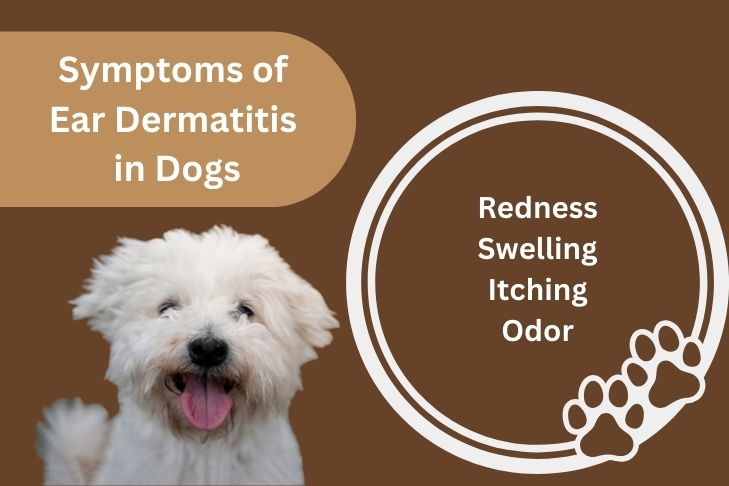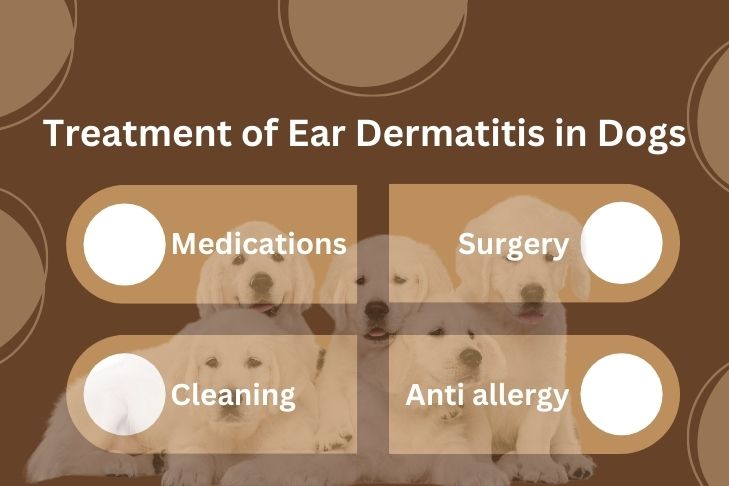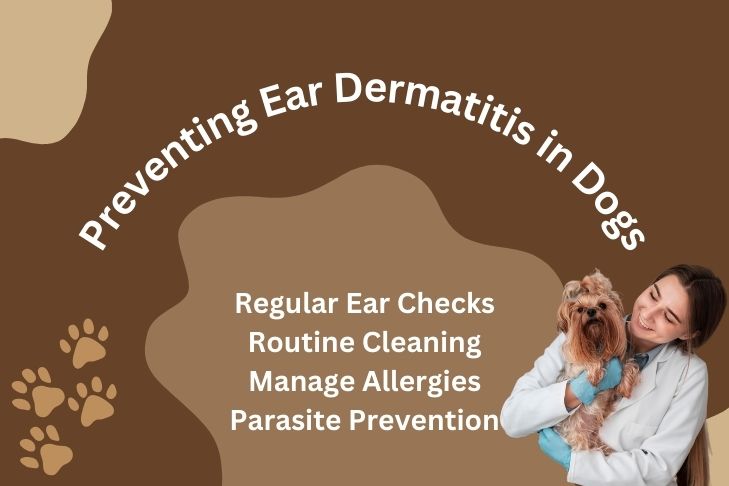When you keep dogs at home, they become an integral part of the family. As responsible dog owners, it’s crucial to keep an eye on their health, including their ears. One common issue that can affect our pup friends is ear dermatitis in dogs.
This condition can cause significant discomfort and lead to more serious health problems if it is not addressed promptly.
In this blog, we’ll explore what ear dermatitis is, its causes, symptoms, treatment options, and preventive measures to keep your dog’s ears healthy and happy.
So, let’s dig in!
What is Ear Dermatitis in Dogs?

Ear dermatitis refers to inflammation of the skin inside the ear canal or on the external ear flap (pinna).
This inflammation can be caused by some factors, leading to itchiness, redness, and sometimes infection.
Ear dermatitis can affect big fluffy dogs or even small little pups of all breeds and ages, but some may be more predisposed due to their ear structure or environmental factors.
Check Blog On Dog Lice Treatment
Causes of Ear Dermatitis in Dogs

Identifying the root cause of ear dermatitis is key to effective treatment. Here are some common causes:
- Allergies: Dogs can develop allergic reactions to food, environmental factors (like pollen, dust mites, or mold), and even certain grooming products.
- Parasites: Ear mites are a common cause of ear dermatitis. These tiny parasites can cause intense itching and inflammation, leading to secondary infections if not treated.
- Infections: Bacterial and fungal infections can result in ear dermatitis in dogs. Moist environments inside the ear canal are perfect breeding grounds for these pathogens, especially in dogs with floppy ears that retain moisture.
- Foreign Bodies: Objects such as grass seeds, dirt, or other debris can become lodged in the ear, causing irritation and inflammation.
- Trauma or Injury: Scratches, bites, or other injuries to the ear can lead to dermatitis as the skin tries to heal.
- Hormonal Imbalances: Conditions like hypothyroidism can make dogs more susceptible to skin issues, including ear dermatitis.
Recognizing the Symptoms of Ear Dermatitis in Dogs

Ear dermatitis can cause a variety of symptoms, some of which are easily noticeable. Here’s what to look for:
- Redness and Swelling: The skin inside the ear or on the ear flap may appear red and swollen.
- Itching and Scratching: Dogs with ear dermatitis often scratch their ears or shake their heads frequently, which end up creating dark itchy spots on dogs skin.
- Discharge: You may notice a yellow, brown, or bloody discharge from the ear.
- Odor: Infections associated with ear dermatitis can produce a foul odor.
- Pain and Sensitivity: Your dog may show signs of discomfort or pain when you touch their ears.
- Scabs or Crusts: These can form on the ear flap or around the ear canal.
Treatment Options for Ear Dermatitis in Dogs

The treatment for ear dermatitis in your chunky dog will depend on the underlying cause. Here are some common treatment approaches:
- Medications: Your vet may prescribe topical or oral medications, such as antibiotics for bacterial infections, antifungals for yeast infections, or anti-inflammatory drugs to reduce swelling and discomfort.
- Cleaning: Cleaning up your dog’s ears to remove debris and prevent infections. Your vet can recommend an appropriate ear cleaner and show you how to use it safely.
- Addressing allergies: If allergies are the cause, identifying and eliminating the allergen is crucial. This may involve changes in diet, using hypoallergenic grooming products, or managing environmental allergens.
- Parasite Control: If ear mites or other parasites are the culprits, your vet will prescribe medications to eliminate them and prevent re-infestation.
- Surgery: In severe cases where chronic ear infections have caused structural damage, surgery might be necessary to correct the problem and prevent further issues.
How to Prevent Ear Dermatitis in Dogs

If you suspect your dog may have ear dermatitis because of the constant ear scratching or any other sign, make sure to take preventative measures before it gets worse.
Here are some tips to help prevent ear dermatitis in your dog:
- Regular Ear Checks: Make it a habit to check your dog’s ears regularly for signs of redness, discharge, or odor.
- Routine Cleaning: Clean your dog’s ears as recommended by your vet. This helps keep the ear canals free of debris and reduces the risk of infection.
- Manage Allergies: Work with your vet to identify and manage any allergies your dog may have. This might involve dietary changes, medications, or environmental adjustments.
- Parasite Prevention: Use regular flea and tick preventatives to protect your dog from parasites that can cause ear dermatitis.
Conclusion
Ear dermatitis in dogs is a common but manageable condition. Understanding the causes and symptoms is very important, as they enable you to follow the right treatment for your furry little friend and take timely measures!




